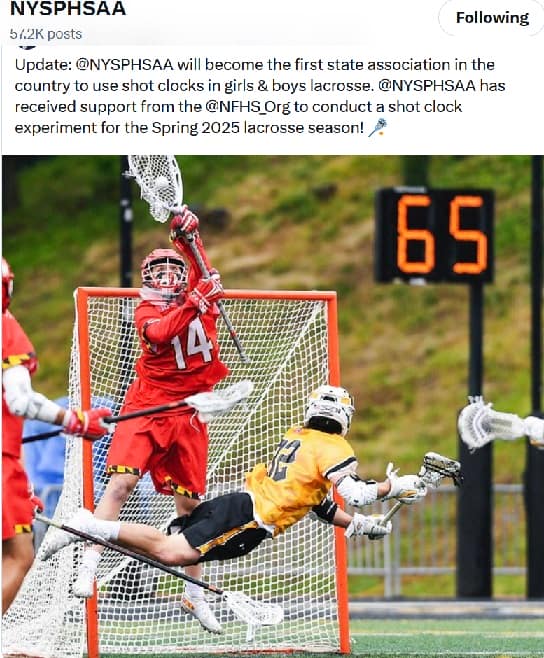Leading off today: An announcement two weeks ago that flew under the radar a bit while fall sports teams were gearing up could forever change high school lacrosse for reasons beyond the obvious.
On Aug. 26, the NYSPHSAA announced that the National Federation of State High School Associations approved the implementation of an experimental shot clock for the association's boys and girls lacrosse teams in 2025. Various other states have used shot clocks to some extent, but New York's decision to dip a toe into the proverbial water could go a long way toward the NFHS ultimately making shot clocks a national standard.
The boys game will introduce a 60-second shot clock while maintaining the 20-second clearing rule. Following the successful clear, attacking teams will continue to have 10 additional seconds to get the ball into the offensive box. The girls game will have a 90-second shot clock upon change of possession. Clocks for both genders will reset for a saved shot or one dinging a pipe.
The obvious effect is going to be the end of prolonged clock-killing possessions late in close games. Teams will no longer play keep-away with no intent of actually attacking the net. By extension, goalies should expect to face more shots, and there will presumably be a slight uptick in scoring.
However, coaches and sport officials interviewed by USALacrosse.com point to other changes they consider to be inevitable. Among them is Mike Pressler, who has coached NCAA teams into tournament semifinals or finals in Divisions I, II, and III.

"Having two-way middies is a must," said Pressler, now a high school coach in Texas where a shot clock is used on a limited basis. "The days of the O-middie in high school are over, in my opinion. The true D-middies and the two-way guys play the entire game. And the O-middies, you just don't have time to get them on the field, much less time to get them off the field."
The anticipated more scoring translates to more faceoffs, which theoretically benefits teams with top-notch FOGO specialists or two-way middies who stand out on the X. But Bryan Kelly, who coaches Maryland powerhouse Calvert Hall, likes that the team winning the draw will have to settle into its offense with more urgency, and more possessions will ensue because of the shot clock.
"It really allows the team that's playing the best to win," Kelly said. "You can't stall, you can't slow the game down, you have a certain timeframe to make something happen. And if you don't, the ball's going the other way, and it could be two minutes left in the game and you're down by two, you still have a chance to win."
The NYSPHSAA will share data with the NFHS following the 2025 season, and the experiment could extend into 2026. There will be logistics to work out, including training officials and timekeepers, particularly for schools that don't have football play clocks installed on their fields.
One concern for the moment is that the NYSPHSAA experiment is not being done in conjunction with the CHSAA, PSAL, or AIS. Those organizations and state associations in New Jersey and Connecticut -- frequent playing partners for New York teams -- are free to adopt their own shot clock rules. However, inter-association matchups like Long Island powerhouse Chaminade's series against the likes of Ward Melville and Manhasset could go by the wayside without rules consistency.
For his part, Kelly won't even consider playing without a shot clock anymore.
"If you're not running a shot clock, you're not preparing these kids for college," he said.
Keep an eye out for implications down the road
The death of a junior varsity football player last month in Virginia has raised questions about whether the presence of an athletic trainer at the school could have averted the tragedy.
According to WWBT-TV, 15-year-old Jayvion Taylor at Hopewell High School during a water break on Aug. 5 after 40 minutes of drills. Two coaches attended to him until paramedics arrived seven minutes after the 911 call and transported the boy to the hospital where he later died.
The TV station reported that a school employee said the school hasn't had an athletic trainer since last school year. "That comfort of having a trained medical professional on site, just in case anything were to happen, was always there. But then, they cut the trainer," the source said.
Shortly after the death, school officials said an athletic trainer's hiring was pending. However, the job posting was still on the school's website.
The circumstances surrounding Taylor's death are likely to lead to questions of oversight that may be taken up beyond that Virginia school district. The lack of an onsite athletic trainer as well as a report that the heat index was in the mid- to upper-90s could have administrators eveywhere examining their own procedures.
The NYSPHSAA's recommendations encourage water breaks every 15 minutes and moitoring athletes for illness when the heat index is in the range of 91 to 95 degrees. The rules require ceasing outside activity if the heat index exceeds 95 degrees.
